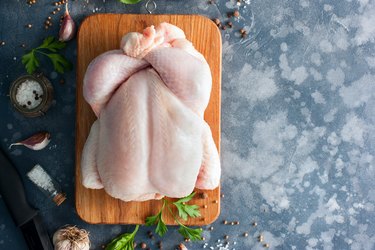
If you've ever thawed chicken on the counter, you're risking serious illness. Although well-informed cooks are well aware that chicken is highly susceptible to contamination by harmful bacteria, many still follow the high-risk practice of thawing their chicken at room temperature on the counter.
When major outbreaks of foodborne illness occur, news coverage tends to focus on the food's producers and manufacturers. It makes for good ratings and readership, but glosses over the fact that good food handling in the home — not thawing a chicken on the counter — can sharply reduce the risks.
Video of the Day
Video of the Day
Tip
Follow safe thawing practices, such as thawing meat in the fridge or in cold water, to help prevent foodborne illness from chicken.
Read more: How to Bake a Plain Chicken Breast
Safety of Chicken: Room Temperature
Thawing chicken on the counter is not safe. Part of that cavalier attitude stems from a mistaken belief that, since the chicken will be cooked afterwards, it will be food safe by the time it reaches your table. That widely held opinion is inaccurate, sometimes tragically so.
Cooking to a food safe temperature of 165 degrees Fahrenheit, as recommended by the USDA Food Safety and Inspection Service, doesn't kill all of the bacteria. It does reduce their numbers sharply, but the higher the bacteria population before cooking, the more that remain after cooking.
More important, some bacteria associated with chicken — including Staphylococcus aureus and E. coli — produce heat-stable toxins that can make you seriously ill, even after the bacteria are killed.
Follow the Rules
Most bacteria, including the ones that are potentially harmful to humans, reproduce best within a specific range of temperatures. Below 40 F or above 140 F they're busy trying to survive, and that means they aren't reproducing in your food.
That's why refrigerators keep foods below 40 F, and restaurant steamer tables keep it above 140 F. The hundred degrees in between is referred to as the food safety "danger zone," where bacteria can reproduce freely, as described by the USDA. That's important, because most dangerous bacteria must reach a specific population before they can make you ill.
When you thaw chicken at room temperature, the outer edges can begin breeding bacteria before the middle begins to thaw.
Use Safe Thawing Techniques
Rather than leaving chicken out on your kitchen counter, follow one of the handful of foodsafe thawing techniques, as recommended by the USDA. The best is simply to leave the chicken in your fridge until it thaws. That way, it never reaches an unsafe temperature.
If you haven't thought that far ahead, Michigan State University Extension says that you can safely thaw chicken by placing it in a sealed, leak-proof bag and placing the bag in cold water. This can take as little as 30 minutes for small boneless cuts. Defrosting chicken in hot water is not safe. This can begin to cook the superficial meat before the middle is thawed.
As a last resort, you can thaw the chicken in your microwave on the defrost setting after unwrapping the chicken and removing any foam inserts or trays, notes the University of Nebraska Lincoln Extension. You should only use the microwave if you're going to cook the chicken immediately, because it heats unevenly and can create "hot spots" where bacterial activity is high.
Read more: General Nutrition Facts About Chicken
Keep It Clean
If you've thawed your chicken safely and cooked it to the appropriate temperature, you've made a good start. However, there are a few other important points that contribute to complete food safety at home.
First, wash your hands, work surfaces and utensils scrupulously with hot, soapy water before you start. That minimizes the risk of bringing bacteria to the chicken yourself. Second, wash and sanitize any surface the raw chicken has touched. Never use the same hand, or utensils, to handle other foods after they've touched raw chicken.
Finally, once the bird is cooked, handle the leftovers safely. Get them into your fridge or freezer within two hours of the meal, so bacteria can't become reestablished.
- USDA Food Safety and Inspection Service: "Chicken From Farm to Table"
- USDA Food Safety and Inspection Service: "The Big Thaw — Safe Defrosting Methods for Consumers"
- USDA Food Safety and Inspection Service: "Danger Zone" (40 F - 140 F)"
- Michigan State University Extension: "The Big Thaw – Four Ways to Thaw Meat Safely"
- University of Nebraska Lincoln Extension: "Thawing Meat and Poultry Safely"